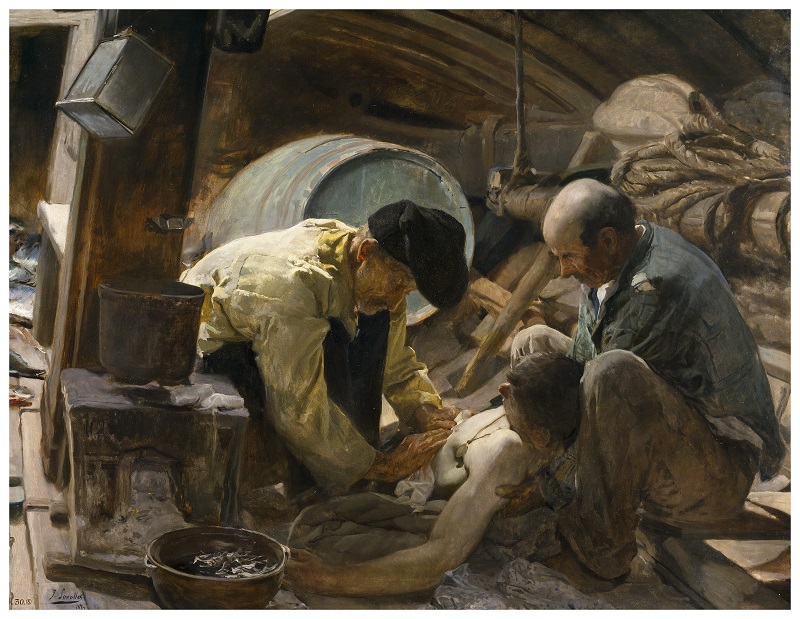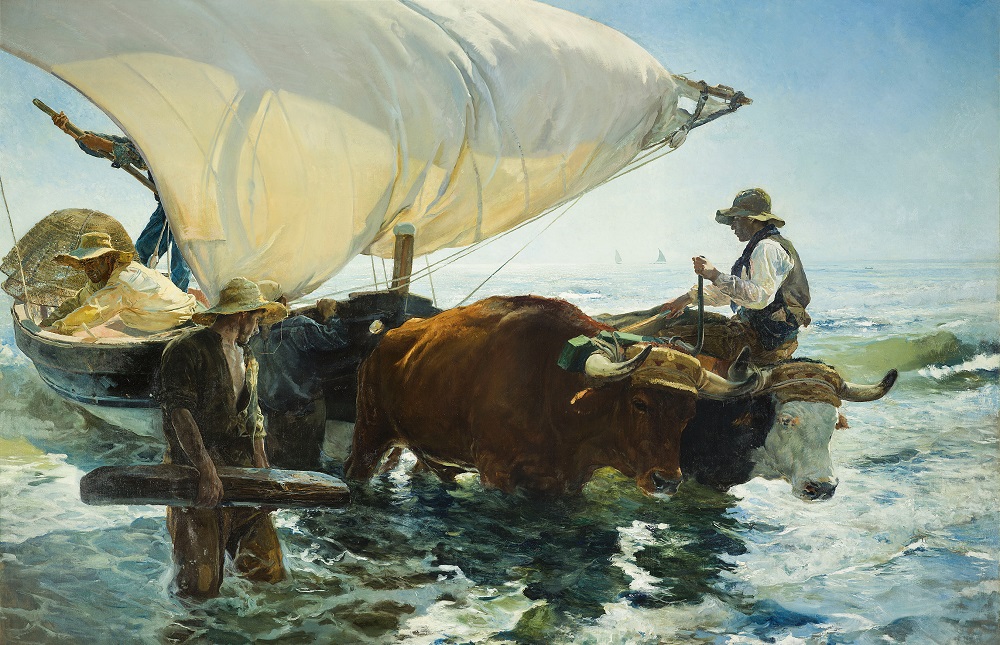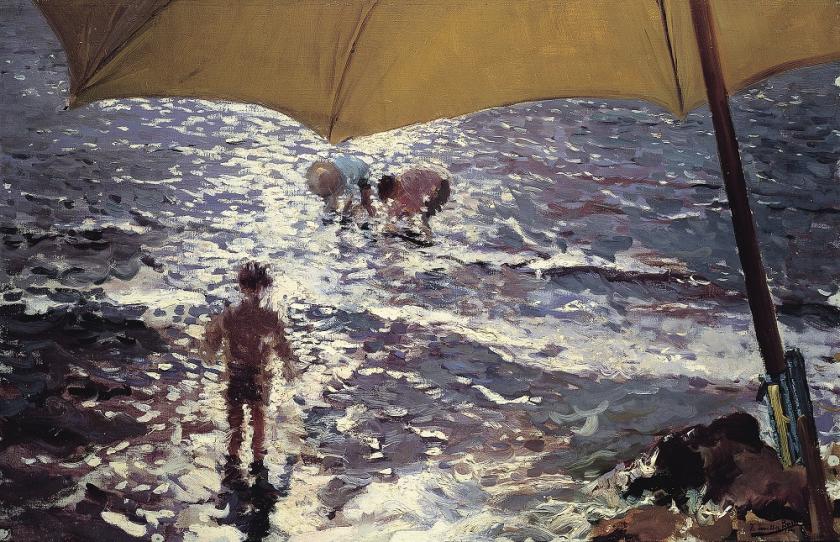The National Gallery is on a roll to expand ever further our understanding of western art, alternating blockbusters dedicated to familiar and bankable stars, with selections of work by lesser known figures from across the centuries. Last year for example we had the Finnish Gallen-Kallela, the American Thomas Cole and the Renaissance painter Lorenzo Lotto.
Now it is the turn of the Spaniard Joaquín Sorolla, (1863-1923) billed in 1908 as the "World’s Greatest Living Painter" for an exhibition at London’s Grafton Galleries, the first and last time he was to be shown in Britain. His reception in London was tepid, but in Europe and North America the prizes rained down like confetti and the sales were awesome. He is still adored in Spain, and remains their best loved native painter no matter how little known he is elsewhere.
Here, 60 paintings represent his entire career: portraits of family, friends, fellow artists; social realism; and perhaps above all the beach, the sea, and gardens. He was addicted to light, and to light glinting off the sea, and declared that he wanted to represent nature in reality, and to go beyond conventionality. Born in Valencia, a city drenched in sunlight, Sorolla was orphaned by the age of two and brought up by his uncle and aunt, who recognised his talent early on. By his early thirties he had an international reputation, had travelled and exhibited extensively in Europe, and would conquer America under the auspices of the American millionaire Archer Milton Huntington, founder of the Hispanic Society in New York. He painted the young King of Spain (Alfonso XIII), also the King’s English mother in law, Princess Beatrix, Victoria’s daughter (the only Sorolla in a British national collection) and William Howard Taft, the US President. In his fifties, he was to spend three years on one of the most enormous commissions conceivable, Vision of Spain – fourteen panels, extending 70 metres, of the regions of Spain, all painted in situ on his travels throughout the country, and installed in the Hispanic Society which is the most extensive collection of Hispanic materials outside Spain.
Born in Valencia, a city drenched in sunlight, Sorolla was orphaned by the age of two and brought up by his uncle and aunt, who recognised his talent early on. By his early thirties he had an international reputation, had travelled and exhibited extensively in Europe, and would conquer America under the auspices of the American millionaire Archer Milton Huntington, founder of the Hispanic Society in New York. He painted the young King of Spain (Alfonso XIII), also the King’s English mother in law, Princess Beatrix, Victoria’s daughter (the only Sorolla in a British national collection) and William Howard Taft, the US President. In his fifties, he was to spend three years on one of the most enormous commissions conceivable, Vision of Spain – fourteen panels, extending 70 metres, of the regions of Spain, all painted in situ on his travels throughout the country, and installed in the Hispanic Society which is the most extensive collection of Hispanic materials outside Spain.
Sorolla was a friend to John Singer Sargent, knew Whistler, and was among those artists from Manet on who were passionate not only about the artists of the past but in particular were part of the rediscovery internationally of the wonders of Velázquez, not to mention Goya.
Sorolla seems to have been someone absolutely sure of his vocation. He was a very quick painter who painted his beach scenes en plein air. His 1904 Afternoon at the Beach in Valencia (main picture) frames a trio of playful youngsters in the shallows of the glittering sea with a depiction of the vast umbrella which sheltered the working artist. Other scenes show us young girls running along the beach, boys sunning themselves, a young fisherman with a basket full of silvery fish as glinting in the sun as the ruffled water, fishermen pulling up a small sailing dinghy, a white boat gliding towards us pulled through the water by two exuberant young boys. These paintings are full of the artist's delight in the scenes before him.
Earlier in his career, Sorolla had produced a clutch of social realist paintings, in which the sea featured both as a work place and as a form of therapy. Sad Inheritance shows a host of disabled young boys, brought to bathe in the sea by a monk from their orphanage. And They Still Say Fish is Expensive! using a justifiably dark and shadowy range of colour depicts a badly wounded young fisherman tended by two anxious older men in the hull of their working boat (pictured above). In The Return from Fishing (pictured below) two huge oxen guided by three young men pull a fishing boat onto shore; brilliantly composed with artful diagonals and verticals – sail, boat, beasts, men – dignifies the sheer hard work involved making a living by the sea. Sorolla was a passionately devoted family man, and one of his most imaginative renderings is the vast Madre, where only his wife’s head peeps out from among a swathe of white linens, gazing across at the tiny form of her new born daughter, her hand gently touching the baby. Various portraits of his children hint at the psychological complexity of siblings, but are not quite as fascinating John Singer Sargent’s investigations of families - perhaps Sorolla was just too close to his subjects, his emotions softening insight.
Sorolla was a passionately devoted family man, and one of his most imaginative renderings is the vast Madre, where only his wife’s head peeps out from among a swathe of white linens, gazing across at the tiny form of her new born daughter, her hand gently touching the baby. Various portraits of his children hint at the psychological complexity of siblings, but are not quite as fascinating John Singer Sargent’s investigations of families - perhaps Sorolla was just too close to his subjects, his emotions softening insight.
The paintings which are studies for the awesome Hispanic Society murals are, in the 21st century, simply too quaint and picturesque, illustrations of regional customs rather than interpretations. For subjects chosen by himself there are marvellous highlights in paintings that are both more relaxed and more adventurous: the great gardens in Granada and Seville, vistas of the great curved beach at San Sebastián seen from above, and dashingly exuberant images of his favourite models, his wife and daughters, sitting in the garden dappled with sunlight, having a siesta on the lawn.
Sorolla’s 2009 monographic exhibition was the most popular this century at the Prado, Madrid, but in the context of London’s National Gallery the paintings show him as a major minor master, neither as imaginative nor unexpected enough to rank among the innovators who have changed the way we see the world.
- Sorolla: Spanish Master of Light at the National Gallery until 7 July
- More visual arts reviews on theartsdesk









![SEX MONEY RACE RELIGION [2016] by Gilbert and George. Installation shot of Gilbert & George 21ST CENTURY PICTURES Hayward Gallery](/sites/default/files/styles/thumbnail_125_x_125_/public/mastimages/Gilbert%20%26%20George_%2021ST%20CENTURY%20PICTURES.%20SEX%20MONEY%20RACE%20RELIGION%20%5B2016%5D.%20Photo_%20Mark%20Blower.%20Courtesy%20of%20the%20Gilbert%20%26%20George%20and%20the%20Hayward%20Gallery._0.jpg?itok=3oW-Y84i)





Add comment